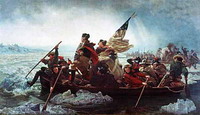Login form
American Revolution

By 1775, King George III of Great Britain was really angry! His 13 colonies in North America seemed bursting with troublemakers who wouldn’t pay their taxes.
King George was determined to force the rebellious colonists to obey him. Instead, their rebellion slid into war—the American Revolution—that lasted from 1775 to 1783 and killed thousands on both sides. When it was over, the colonies had won independence from Britain. With independence came a brand-new nation, the United States of America.
THE TAX PROBLEM
Great Britain fought a costly war with France from 1754 to 1763. By the end of the war, Britain owed other countries lots of money. British officials decided the American colonies should help pay off the debt. That meant new taxes.
The colonists complained. The British actions trampled their rights. Only the elected assembly of a colony could tax the people. The new taxes ripped power away from the colonial assemblies. Britain unfairly wanted tax money without giving the colonists any say in the matter. The colonists referred to this as “taxation without representation.”
Colonists swarmed the streets in protest of British taxes such as the Sugar Act (1764) and Stamp Act (1765). Some people attacked the tax collectors. Other people launched boycotts, refusing to buy British goods. Meanwhile, Great Britain continued to insist on its right to tax the colonists.
WHAT OTHER TROUBLES LED TO WAR?
Many events hardened the feelings of both colonists and the British government. In 1770, British soldiers fired into a mob in Boston, Massachusetts, killing five colonists. In 1773, some citizens protested a tea tax by dumping more than 300 chests of valuable tea into the Boston harbor. This incident became known as the Boston Tea Party. The following year the king punished Boston, closing the town's harbor and sending more soldiers there.
On April 19, 1775, British soldiers got into a fight with colonial militia (armed citizens) at Lexington and Concord, two towns in Massachusetts. The soldiers were searching for weapons owned by colonists. The militiamen grabbed their guns and ran to defend their towns. Men on both sides were killed. Even colonists who supported the king were shocked that his soldiers spilled the blood of the king's own subjects.
In June 1775, members of the Continental Congress asked George Washington to lead the American army (the Continental Army). On July 4, 1776, the Congress issued the Declaration of Independence. This document officially cut ties with Great Britain. Only war could determine if the colonies became free and independent states or remained part of Great Britain.
HOW DID THE WAR AFFECT AMERICANS?
The war became the main force in the American people’s lives for eight hard years. Battles and marching armies forced thousands of people to flee their homes. Both armies seized food, animals, and other goods from citizens, often without paying. Prices for everything skyrocketed and goods grew scarce. American paper money became so worthless that many stores and other businesses refused to accept it.
Thousands of men served in state militias or the Continental Army. Women and children remained at home and did the men’s jobs, as well as their own work.
While many Americans supported independence, a great number of people stayed loyal to the king. These Loyalists (or Tories) helped the British soldiers. Bitterness and violence divided the Loyalists and patriots, turning neighbor against neighbor.
Many slaves tried to escape by joining the British army, which promised freedom for slaves who helped them. Other slaves and free black people joined the American forces. Some slaves fought in place of their masters in exchange for their freedom.
HOW WAS THE WAR FOUGHT?
Americans hoped to fight the war using militiamen from each colony. But militiamen only served for a short time and then returned home. Americans needed an army of trained soldiers who would fight for a long stretch of time. Holding an army together was a problem throughout the war.
Congress and the American people never provided enough money to feed and dress the Continental soldiers. Men starved and froze in winter. They lacked proper weapons and ammunition. The soldiers often suffered through these terrible conditions without receiving any pay. Some soldiers even left the army and headed home.
During the war, the British captured most of America's main cities: Boston, New York, Philadelphia, Newport, Savannah, and Charleston. One important American victory happened at Saratoga, New York, in October 1777. The British defeat helped persuade France, an old enemy of Great Britain, to aid the Americans with money and soldiers. This was a key turning point in the war.
HOW DID THE AMERICANS WIN?
The British could never manage to destroy the American army. In October 1781, American and French armies forced the British general George Cornwallis to surrender at Yorktown, Virginia. This defeat convinced many people in Great Britain that the war had become a waste of money and men.
American negotiators in Europe, including John Adams and Benjamin Franklin, reached a peace agreement in November 1782. The final treaty was signed in September 1783. Britain agreed to recognize American independence. A new nation was born.
Source: Microsoft ® Encarta

